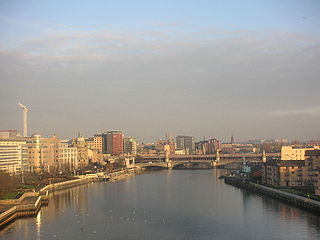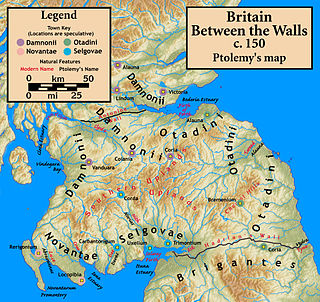
Strathclyde, originally Cumbric: Ystrad Clud or Alclud, was one of the early medieval kingdoms of the Britons in Hen Ogledd, the Brythonic-speaking parts of what is now southern Scotland and northern England. The kingdom developed during the post-Roman period. It is also known as Alt Clut, a Brittonic term for Dumbarton Castle, the medieval capital of the region. It may have had its origins with the Brythonic Damnonii people of Ptolemy's Geography.

Clydebank is a town in West Dunbartonshire, Scotland. Situated on the north bank of the River Clyde, Clydebank borders Dumbarton and the villages of Old Kilpatrick, Bowling and Milton to the west, as well as the town of Bearsden in East Dunbartonshire, and the Yoker and Drumchapel areas of the adjacent City of Glasgow. Historically part of Dunbartonshire, Clydebank is part of the registration County of Dumbarton, the Dunbartonshire Crown Lieutenancy area, and the wider urban area of Greater Glasgow. Clydebank was founded as a police burgh on 18 November 1886.
Quintus Lollius Urbicus was a Berber governor of Roman Britain between the years 139 and 142, during the reign of the Emperor Antoninus Pius. He is named in the Historia Augusta, although it is not entirely historical, and his name appears on five Roman inscriptions from Britain; his career is set out in detail on a pair of inscriptions set up in his native Tiddis, near Cirta, Numidia.

Old Kilpatrick, is a village in West Dunbartonshire, Scotland. It has an estimated population of 4,820. It belonged to the parish of Old Kilpatrick which itself was only a few thousand people strong.

Cadder is a district of the town of Bishopbriggs, East Dunbartonshire, Scotland. It is located 7 km north of Glasgow city centre, 0.5 km south of the River Kelvin, and approximately 1.5 km north-east of Bishopbriggs town centre, sited on the route of the Forth and Clyde Canal. There is a Glasgow council housing scheme of a similar name, generally pronounced Cawder, in the district of Lambhill some 3 miles (5 km) to the south-west along the Canal, which was built in the early 1950s. Similarly, within Cadder, there is Cawder Golf Club, which also uses that original pronunciation.

Bonnybridge is a small village in the Falkirk council area of Scotland. It is 4.0 miles (6.4 km) west of Falkirk, 5.3 miles (8.5 km) north-east of Cumbernauld and 8.3 miles (13.4 km) south-southwest of Stirling. The village is situated near the Bonny Water which runs through the town and lies north of the Forth and Clyde Canal. To the south-east of Bonnybridge is a well-preserved section of the Antonine Wall, and the remnants of Rough Castle Fort, the most complete of the surviving Roman forts of the wall.

Rough Castle Fort is a Roman fort on the Antonine Wall roughly 2 kilometres south east of Bonnybridge near Tamfourhill in the Falkirk council area, Scotland. It is owned by the National Trust for Scotland.

Castlecary is a small, historic, village in North Lanarkshire, Scotland. It has long been associated with infrastructure, being adjacent to a bridged river, a Roman fort and roads, a nationwide canal, a Victorian railway viaduct, and a modern motorway. Castlecary is close to the town of Cumbernauld but like Dullatur and Luggiebank is not officially part of the town. Around 1725, the barony of Castlecary, with a population of just seventeen families, was disjoined from the parish of Falkirk, and annexed to Cumbernauld quoad sacra. Castlecary is also near Allandale which, though in the Falkirk council area, was built for Castlecary fireclay workers.
Clyde is a surname, and may refer to:

Balmore is a small village in East Dunbartonshire, Scotland, located 1 km west of Torrance and 5 km east of Milngavie.
Events from the 2nd century in Roman Britain.

Scotland during the Roman Empire refers to the protohistorical period during which the Roman Empire interacted with the area that is now Scotland, which was known to them as "Caledonia". Roman legions arrived around AD 71, having conquered the Celtic tribes of "Britain" over the preceding three decades. Aiming to annex all of the island of "Albion", Romans under Q. Petilius Cerialis and Gn. Julius Agricola invaded the Caledonians in the 70s and 80s.

The Antonine Wall, known to the Romans as Vallum Antonini, was a turf fortification on stone foundations, built by the Romans across what is now the Central Belt of Scotland, between the Firth of Forth and the Firth of Clyde. Representing the northernmost frontier barrier of the Roman Empire, it spanned approximately 63 kilometres and was about 3 metres high and 5 metres wide. Lidar scans have been carried out to establish the length of the wall and the Roman distance units used. Security was bolstered by a deep ditch on the northern side. It is thought that there was a wooden palisade on top of the turf. The barrier was the second of two "great walls" created by the Romans in what the English once called Northern Britain. Its ruins are less evident than the better-known Hadrian's Wall to the south, primarily because the turf and wood wall has largely weathered away, unlike its stone-built southern predecessor.

Tamfourhill is a working-class residential suburb of Falkirk within the Falkirk, Scotland. It is located approximately 1.5 miles west of the city centre. The Falkirk Wheel is located just to the northwest of the village. Tamfourhill includes the residential area between the south side of the Forth & Clyde Canal and the north side of the Union Canal. It also contains the Tamfourhill Industrial Estate. To the west of the village is a well preserved part of the Antonine Wall, built in the 2nd century and Rough Castle.

The architecture of Scotland in the Roman era includes all building within the modern borders of Scotland, from the arrival of the Romans in northern Britain in the first century BCE, until their departure in the fifth century. Although Ptolemy indicated that there were 19 "towns" in Caledonia, north of the Roman province of Britannia, no clear evidence of urban settlements has been found and these were probably hillforts. There is evidence of over 1,000 such forts, most below the Clyde-Forth line, but the majority seem to have been abandoned in the Roman period. There is also evidence of distinctive stone wheelhouses and small underground souterrains.

Glasgow Bridge is the site of a road bridge over the Forth and Clyde Canal; it is also the site of a Roman fortlet, on the Antonine Wall, half way between the Roman forts at Kirkintilloch and Cadder.

Seabegs Wood was the site of a Roman fortlet on the Antonine Wall in Scotland.

Balmuildy is the site of a Roman fort on the Antonine Wall in Scotland. It is one of only two forts on the Antonine Wall to have been found with stone ramparts; the other is Castlecary. A digital reconstruction of the fort has been created.

The line of the Antonine Wall runs roughly parallel between the River Kelvin to the north and the Forth and Clyde Canal to the south.




















